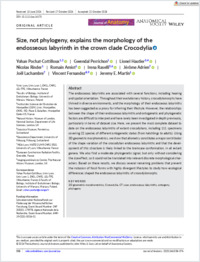Size, not phylogeny, explains the morphology of the endosseous labyrinth in the crown clade Crocodylia
DOKPE
- Pochat‐Cottilloux, Yohan ORCID University of Lyon
- Perrichon, Gwendal ORCID University of Lyon
- Hautier, Lionel ORCID University of Montpellier
- Rinder, Nicolas University of Lyon
- Amiot, Romain ORCID University of Lyon
- Raselli, Irena ORCID University of Fribourg
- Adrien, Jérôme ORCID University of Lyon
- Lachambre, Joël University of Lyon
- Fernandez, Vincent ORCID European Synchrotron Radiation Facility Grenoble, France
- Martin, Jeremy E. ORCID University of Lyon
- 2024
Published in:
- Journal of Anatomy. - Wiley. - 2024, vol. 246, no. 4, p. 558-574
English
The endosseous labyrinths are associated with several functions, including hearing and spatial orientation. Throughout their evolutionary history, crocodylomorphs have thrived in diverse environments, and the morphology of their endosseous labyrinths has been suggested as a proxy for inferring their lifestyle. However, the relationships between the shape of their endosseous labyrinths and ontogenetic and phylogenetic factors are difficult to interpret and have rarely been investigated in depth previously, particularly in terms of dataset size. Here, we present the most complete dataset to date on the endosseous labyrinths of extant crocodylians, including 111 specimens covering 22 species of different ontogenetic status (from hatchlings to adults). Using 3D geometric morphometrics, we show that allometry constitutes a major contributor of the shape variation of the crocodylian endosseous labyrinths and that the development of this structure is likely linked to the braincase conformation, in all extant genera. We also find a moderate phylogenetic signal, but only without considering the size effect, so it could not be translated into relevant discrete morphological characters. Based on these results, we discuss several remaining problems that prevent the inclusion of fossil forms with highly divergent lifestyles to study how ecological differences shaped the endosseous labyrinths of crocodylomorphs.
- Faculty
- Faculté des sciences et de médecine
- Department
- Département des Géosciences
- Language
-
- English
- Classification
- Palaeontology
- License
- CC BY-NC-ND
- Open access status
- hybrid
- Identifiers
-
- DOI 10.1111/joa.14170
- ISSN 0021-8782
- Persistent URL
- https://folia.unifr.ch/unifr/documents/331972
Statistics
Document views: 4
File downloads:
- journalofanatomy-2024-pochatcottilloux-sizenotphylogenyexplainsthemorphologyoftheendosseouslabyrinthin.pdf: 10
